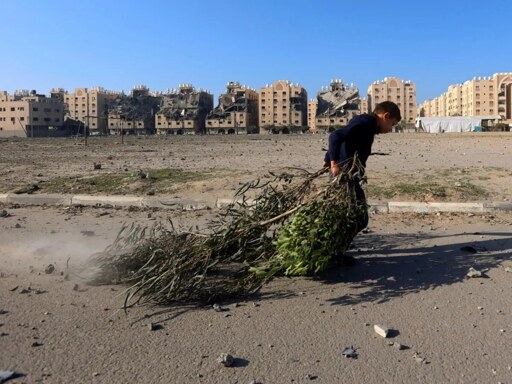The month of October in Gaza is no longer associated with the sounds of harvesting and the smell of olives, as it was for decades. The olive trees that once stretched across thousands of dunams throughout Gaza are now silent, turned into dead land covered with traces of Israel’s bombing and military vehicles.
Israel has erased the olive trees from Gaza
Before the war, Gaza had around 50,000 dunams planted with olive trees, producing more than 35,000 tonnes of olives annually from over a million trees. But after two years of continuous aggression, the cultivated area has shrunk to only about 4,000 dunams, after about 75% of the trees were destroyed or burned, according to the Ministry of Agriculture in Gaza.
The halt in harvesting has led to the silence of the presses and the decline of agricultural activity, amid electricity and fuel shortages and the destruction of much of the agricultural infrastructure. The road to the fields is fraught with danger, and the presses, which were once economic and social centres, have been either destroyed or shut down.
A farmer from Khan Yunis told the Canary:
We used to start the day by picking olives and carrying them in baskets, singing to our land, but today I pass by the field and see nothing but ashes. No shade, no branches, no birds. Everything has changed.
The harvest in Gaza was not just an economic activity, but a social and spiritual ritual. Everyone participated, young and old, men and women, making it a symbol of attachment to the land and memory. A farmer from Beit Hanoun told the Canary:
Every olive tree has its own history. Some were planted by our grandfathers decades ago. Their destruction is like the death of a part of the family.
Beyond its social and symbolic significance, olives are a vital source of income for thousands of families in Gaza, and small farmers depend on them to cover their daily living expenses.
Knock-on effects
With production declining and the vast majority of trees destroyed, the sector faces the risk of losing an entire generation of agricultural expertise, which could limit the ability to replant and develop production in the future. Agricultural experts warn that continued losses could transform olives from a sustainable economic resource into a threatened memory, making agricultural reconstruction, the introduction of modern techniques and support for farmers urgent priorities to ensure the continuation of this ancient national heritage.
The eastern strip of the Strip stretches from Rafah in the south to Beit Hanoun in the north and comprises about 45% of Gaza’s agricultural land, or about 167,000 dunums distributed among vegetables, field crops and tree orchards. Today, the occupation controls about 45% of this land within what is known as the ‘Yellow Line,’ preventing farmers from accessing it and imposing severe restrictions on agricultural movement.
The damage to harvests has been compounded by water and fertiliser shortages, the disruption of agricultural supplies due to the blockade, and the targeting of any movement near the border by snipers. The Palestinian Research Foundation (MAS) reports that agricultural production in the sector has declined by more than 80% over the past two years, with olives particularly affected due to their location in the eastern areas most vulnerable to bombing.
An unprecedented challenge
Gaza no longer celebrates the olive season, but mourns it. The presses are idle, and the branches that once reached for the sky now lie stretched out on the ash-covered ground, bearing witness to the destruction of olive trees, the loss of livelihood for thousands of families, and the shattering of part of the Strip’s agricultural memory.
Today, the olive season in Gaza faces an unprecedented challenge.
The fields that witnessed generations of resilience have been reduced to ashes, and the presses that were once bustling with life have fallen silent. What remains of the olive trees represents a faint hope for the continuation of a decades-old agricultural and cultural heritage, but it faces constant threats from restrictions, siege and destruction.
Amidst this suffering, the biggest question remains: how will Gaza be able to preserve its agricultural and community heritage and ensure the livelihoods of thousands of families if the challenges continue without urgent intervention and sustained support to restore life to the fields and branches that once stretched towards the sky?
Featured image via the Canary
By Alaa Shamali
From Canary via this RSS feed


